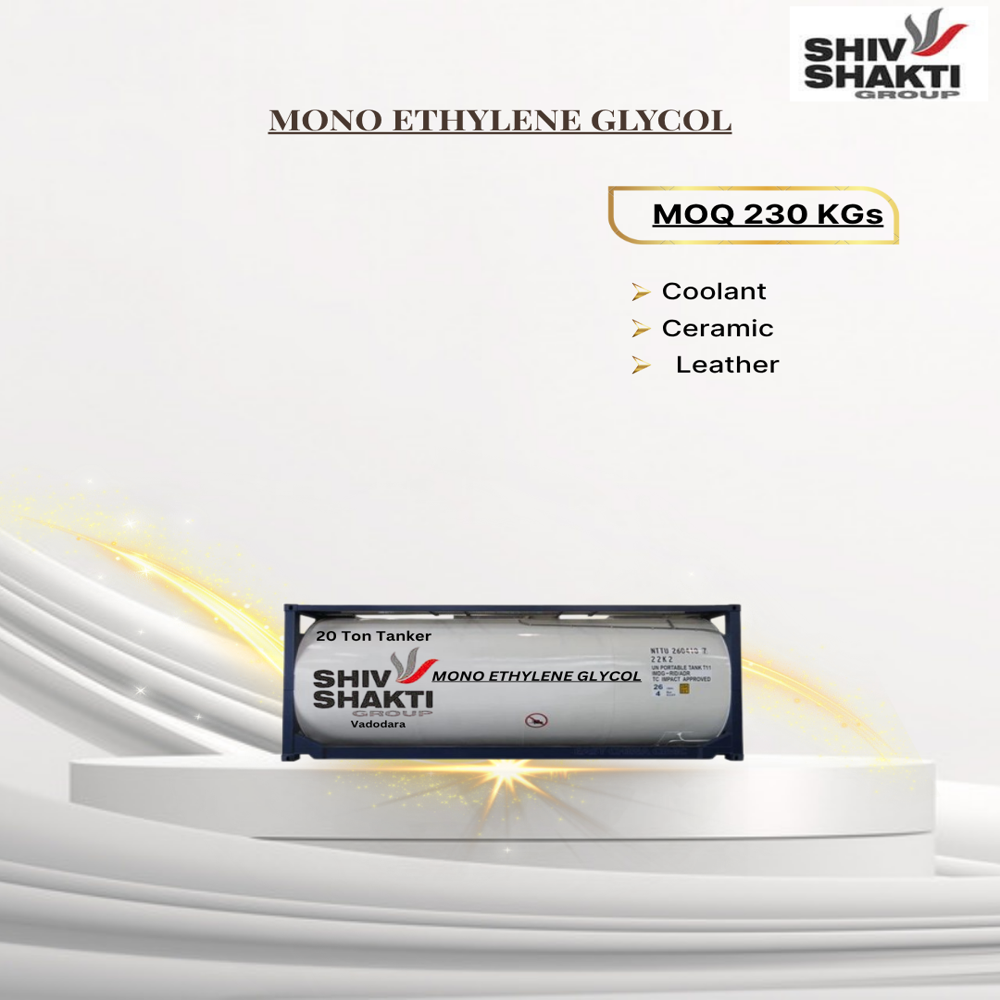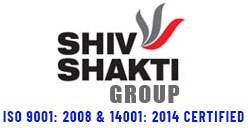Mono Ethylene Glycol
Mono Ethylene Glycol Specification
- Shelf Life
- 3 Years
- Type
- Ethylene Glycol
- CAS No
- 107-21-1
- Viscosity
- 14
- Density
- 1.115 Gram per cubic meter (g/m3)
- Purity
- 99.95
- Ash %
- 0.1
- Appearance
- light yellow to colourless liquid
- Grade
- industrial
- Moisture (%)
- 0.5
- Other Names
- mono ethylene glycol
- Molecular Formula
- HOCH2CH2OH
Mono Ethylene Glycol Trade Information
- Minimum Order Quantity
- 230 Kilograms
- FOB Port
- JNPT
- Payment Terms
- Cash Advance (CA), Cash in Advance (CID), Letter of Credit at Sight (Sight L/C), Telegraphic Transfer (T/T)
- Supply Ability
- 20000 Kilograms Per Month
- Delivery Time
- 3 Days
- Sample Available
- Yes
- Sample Policy
- Contact us for information regarding our sample policy
- Packaging Details
- 230 kgs HDPE DRUM , 1150 Kgs IBC Tank , Tanker
- Main Export Market(s)
- Asia, Australia, Central America, North America, South America, Africa, Eastern Europe, Western Europe, Middle East
- Main Domestic Market
- Lakshadweep, Mizoram, Meghalaya, Manipur, Andhra Pradesh, Bihar, Chandigarh, Daman and Diu, Goa, Jharkhand, Odisha, Chhattisgarh, Haryana, Telangana, Tripura, Pondicherry, Uttar Pradesh, Uttarakhand, West Bengal, All India, South India, Central India, West India, North India, East India, Gujarat, Karnataka, Kerala, Punjab, Assam, Delhi, Tamil Nadu, Dadra and Nagar Haveli, Andaman and Nicobar Islands, Arunachal Pradesh, Himachal Pradesh, Jammu and Kashmir, Madhya Pradesh, Maharashtra, Nagaland, Rajasthan, Sikkim
- Certifications
- An ISO 9001,18001, 45001 Certified
About Mono Ethylene Glycol
Mono Ethylene Glycol MEG is accessible in colorless liquid form. Free from odor, this chemical has 62.07 g/mol molar mass. Its density is 1.11. Boiling point and melting point of this chemical are 197 degree C and -12.9 degree C respectively. It is accessible in 99% pure form. It is used to produce polyester fiber, anti freezing agent and coolant. This chemical has been formulated under controlled temperature to maintain its composition balance. Quality of this industrial grade chemical has been checked as per its shelf life, formulation technique, possible toxin content and applications. It is offered in 230 kg drum.
Mono Ethylene Glycol Properties:
- Synonyms: Hypodicarbonous acid, Monoethylene glycol, Ethylene alcohol
- CAS No: 107-21-1
- Chemical Formula: C2H6O2
- HS Code: 29053100
- EC No.: 203-473-3
- Color: Colorless
- Odour: Odourless
- Molecular Weight: 62.07 g/mol
- Density: 1.11
- Melting Point: -12.9 Degree
- Centigrade Boiling Point: 197 Degree
- Centigrade Purity: 99%
- Grade Standard: Industrial Grade
- Physical State: Liquid
Usage/Application: Raw material for antifreeze, Production of polyester fibers, Coolant
FAQs of Mono Ethylene Glycol:
Q: What is the purity level of Mono Ethylene Glycol?
A: The purity level of Mono Ethylene Glycol is 99.95%.Q: What is the shelf life of Mono Ethylene Glycol?
A: The shelf life of Mono Ethylene Glycol is 3 years.Q: What is the appearance of Mono Ethylene Glycol?
A: Mono Ethylene Glycol appears as a light yellow to colorless liquid.Q: What is the density of Mono Ethylene Glycol?
A: The density of Mono Ethylene Glycol is 1.115 Gram per cubic meter (g/m3).Q: What is the moisture content in Mono Ethylene Glycol?
A: The moisture content in Mono Ethylene Glycol is 0.5%.





Price 65.0 INR/ Kilograms
- Minimum Order Quantity
- 230 Kilograms
- Supply Ability
- 20000 Kilograms Per Month
- Delivery Time
- 3 Days
- Main Domestic Market
- Lakshadweep, Mizoram, Meghalaya, Manipur, Andhra Pradesh, Bihar, Chandigarh, Daman and Diu, Goa, Jharkhand, Odisha, Chhattisgarh, Haryana, Telangana, Tripura, Pondicherry, Uttar Pradesh, Uttarakhand, West Bengal, All India, South India, Central India, West India, North India, East India, Gujarat, Karnataka, Kerala, Punjab, Assam, Delhi, Tamil Nadu, Dadra and Nagar Haveli, Andaman and Nicobar Islands, Arunachal Pradesh, Himachal Pradesh, Jammu and Kashmir, Madhya Pradesh, Maharashtra, Nagaland, Rajasthan, Sikkim
- Main Export Market(s)
- Asia, Australia, Central America, North America, South America, Africa, Eastern Europe, Western Europe, Middle East

Price:
- 50
- 100
- 200
- 250
- 500
- 1000+
More Products in Industrial Glycols Category
Liquid Ethylene Glycol
Price 40 INR / Kilograms
Minimum Order Quantity : 230 Kilograms
CAS No : 107211
Purity : 99%
Grade : Ethylene glycol
Shelf Life : 2 Years
Mix Glycol
Price 45.00 INR / Kilograms
Minimum Order Quantity : 230 Kilograms
CAS No : Mix glycol
Purity : Mixture of Ethylene glycol
Grade : Industrial Grade
Shelf Life : 12 Months
Ethylene Glycol - Mix Glycol (MEG DEG)
Price 35.0 INR / Kilograms
Minimum Order Quantity : 230 Kilograms, Kilograms
CAS No : 107211
Purity : 80%
Grade : Industrial Grade
Shelf Life : 12 Months
Polyethylene Glycol 400 PEG 400
Price 120 INR / Kilograms
Minimum Order Quantity : 225 Kilograms
CAS No : 25322683
Purity : 99%
Grade : Industrial Grade
Shelf Life : 12 Months








 English
English Spanish
Spanish French
French German
German Italian
Italian Chinese (Simplified)
Chinese (Simplified) Japanese
Japanese Korean
Korean Arabic
Arabic Portuguese
Portuguese